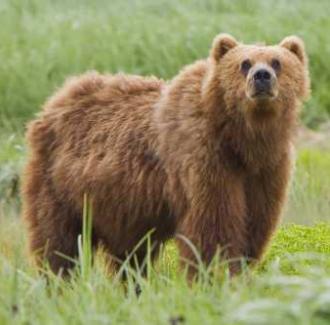 SKC Films Library SKC Films Library |
| SKC Films Library >> Science >> Zoology >> Mammals >> Order Carnivora >> Family Ursidae |
| Kodiak Bear Ursus arctos middendorrfi
Description The largest subspecies of brown bear, a Kodiak can be up to 10 feet tall when standing upright and weigh 1,400 pounds; females are smaller overall but still larger than most other bears. The large overall size includes an enormous head with powerful teeth and jaws and a bulky body that can store fat for the winter. The claws are very long and sharp. This particular subspecies is brown in color, with the overall coloring on the face lighter than than the rest of the body; this is the easiest way to distinguish a Kodiak from a grizzly bear. Distribution and Habitat This bear got its name because it is only found in the Kodiak Archipelago in Alaska. Its ancestors branched off from other North American bears during the last ice age about 10,000 to 12,000 years ago. The lack of natural predators and an abundance of food in the archipelago allowed the Kodiak to grow much larger than its cousins. Thos same factors have also allowed it to thrive, and the Kodiak is one of the few bears to enjoy fairly stable population numbers. Diet Fish are an important part of the Kodiak's diet, especially during the May-through-September salmon run, but it will more often spend its time feeding on vegetation rather than put in the time and effort required to hunt and kill animals. It also feeds on several types of berries, seaweed, and invertebrates, as well as carrion. Reproduction Mating season runs from May through June, when food is the most plentiful. Unlike most other bears, Kodiak males only mate with one female per year, reducing competition between males for mating rights. Fertilized eggs are not implanted until October or November, and 2-3 cubs are born in either January or February of the following year, while the mother is hibernating. The mortality rate of Kodiak cubs is higher than that of other bears, with cannibalism by adult males being one of the major causes of death. Surviving cubs stay with their mother for about three years, during which time she will refuse all mating attempts. Sexual maturity is reached at about five years, but most females will not bear offspring until they are about nine years of age. Other Habits and Behaviors Although Kodiak bears are naturally diurnal they can become more nocturnal when faced with competition. While very solitary by nature, Kodiaks do not defend territories. They will also congregate in large numbers where food is abundant, and are intelligent enough to get the food they need by working together when necessary and to avoid unnecessary competition for food sources. Most Kodiak bears dig their dens in mountainsides. Pregnant sows are the first to begin hibernating, usually in late October. Males (boars) are the last to begin hibernating and the first to emerge, in April. Females with offspring sometimes don't emerge until late June. About 25 percent of adult males remain active throughout the winter and don't hibernate at all. Scientific Classification phylum Chordata SEE ALSO |
| SKC Films Library >> Science >> Zoology >> Mammals >> Order Carnivora
>> Family
Ursidae This page was last updated on June 17, 2017. |
